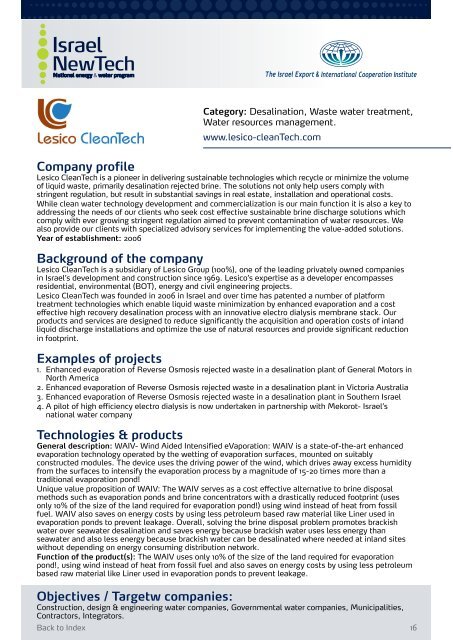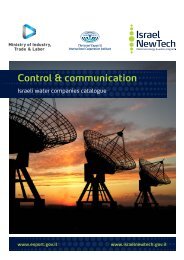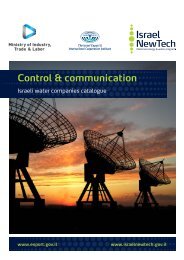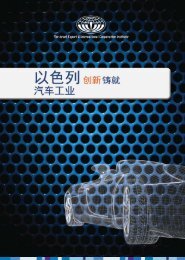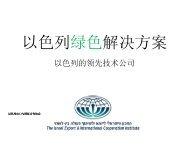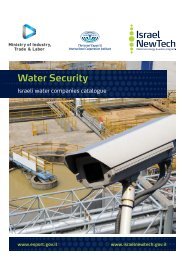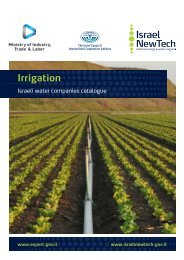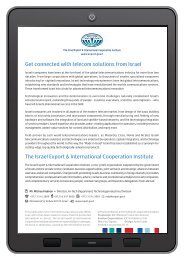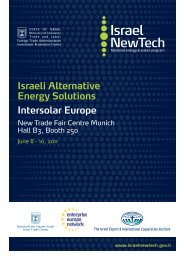Water treatment for Quarries & mines
Water treatment for Quarries & mines
Water treatment for Quarries & mines
You also want an ePaper? Increase the reach of your titles
YUMPU automatically turns print PDFs into web optimized ePapers that Google loves.
Category: Desalination, Waste water <strong>treatment</strong>,<br />
<strong>Water</strong> resources management.<br />
www.lesico-cleanTech.com<br />
Company profile<br />
Lesico CleanTech is a pioneer in delivering sustainable technologies which recycle or minimize the volume<br />
of liquid waste, primarily desalination rejected brine. The solutions not only help users comply with<br />
stringent regulation, but result in substantial savings in real estate, installation and operational costs.<br />
While clean water technology development and commercialization is our main function it is also a key to<br />
addressing the needs of our clients who seek cost effective sustainable brine discharge solutions which<br />
comply with ever growing stringent regulation aimed to prevent contamination of water resources. We<br />
also provide our clients with specialized advisory services <strong>for</strong> implementing the value-added solutions.<br />
Year of establishment: 2006<br />
Background of the company<br />
Lesico CleanTech is a subsidiary of Lesico Group (100%), one of the leading privately owned companies<br />
in Israel’s development and construction since 1969. Lesico’s expertise as a developer encompasses<br />
residential, environmental (BOT), energy and civil engineering projects.<br />
Lesico CleanTech was founded in 2006 in Israel and over time has patented a number of plat<strong>for</strong>m<br />
<strong>treatment</strong> technologies which enable liquid waste minimization by enhanced evaporation and a cost<br />
effective high recovery desalination process with an innovative electro dialysis membrane stack. Our<br />
products and services are designed to reduce significantly the acquisition and operation costs of inland<br />
liquid discharge installations and optimize the use of natural resources and provide significant reduction<br />
in footprint.<br />
Examples of projects<br />
1. Enhanced evaporation of Reverse Osmosis rejected waste in a desalination plant of General Motors in<br />
North America<br />
2. Enhanced evaporation of Reverse Osmosis rejected waste in a desalination plant in Victoria Australia<br />
3. Enhanced evaporation of Reverse Osmosis rejected waste in a desalination plant in Southern Israel<br />
4. A pilot of high efficiency electro dialysis is now undertaken in partnership with Mekorot- Israel’s<br />
national water company<br />
Technologies & products<br />
General description: WAIV- Wind Aided Intensified eVaporation: WAIV is a state-of-the-art enhanced<br />
evaporation technology operated by the wetting of evaporation surfaces, mounted on suitably<br />
constructed modules. The device uses the driving power of the wind, which drives away excess humidity<br />
from the surfaces to intensify the evaporation process by a magnitude of 15-20 times more than a<br />
traditional evaporation pond!<br />
Unique value proposition of WAIV: The WAIV serves as a cost effective alternative to brine disposal<br />
methods such as evaporation ponds and brine concentrators with a drastically reduced footprint (uses<br />
only 10% of the size of the land required <strong>for</strong> evaporation pond!) using wind instead of heat from fossil<br />
fuel. WAIV also saves on energy costs by using less petroleum based raw material like Liner used in<br />
evaporation ponds to prevent leakage. Overall, solving the brine disposal problem promotes brackish<br />
water over seawater desalination and saves energy because brackish water uses less energy than<br />
seawater and also less energy because brackish water can be desalinated where needed at inland sites<br />
without depending on energy consuming distribution network.<br />
Function of the product(s): The WAIV uses only 10% of the size of the land required <strong>for</strong> evaporation<br />
pond!, using wind instead of heat from fossil fuel and also saves on energy costs by using less petroleum<br />
based raw material like Liner used in evaporation ponds to prevent leakage.<br />
Objectives / Targetw companies:<br />
Construction, design & engineering water companies, Governmental water companies, Municipalities,<br />
Contractors, Integrators.<br />
Back to Index<br />
16


